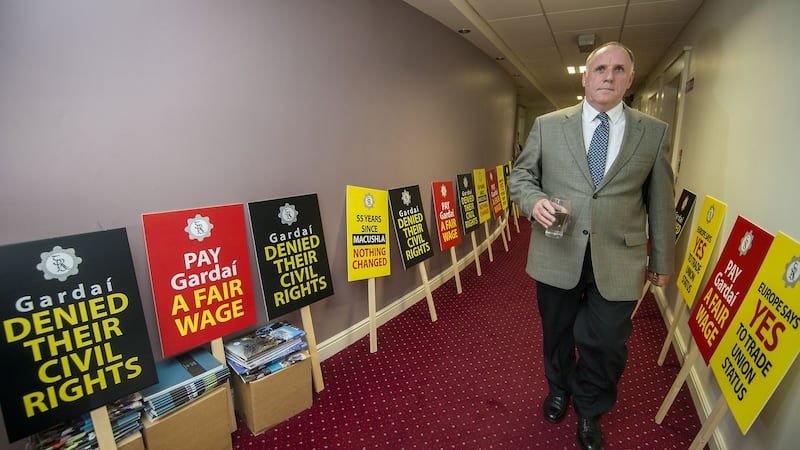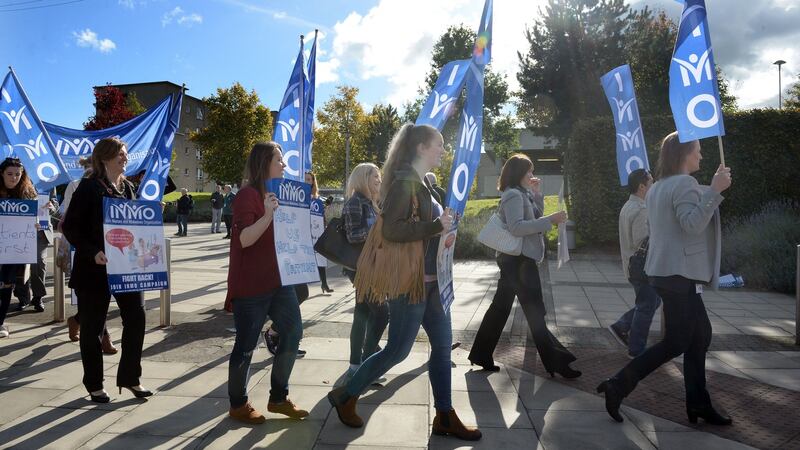It started with the Luas drivers. Back in the first half of last year, drivers embarked on a five-month campaign over an initial claim for a 54 per cent rise over four years in the face of a company offer based on the historically low level of inflation.
At the time, the concern was that any settlement with the drivers would trigger a domino effect with other transport sector workers. And that is precisely what happened. The Luas drivers had barely returned to work having agreed an 18 per cent increase in pay over 4½ years than Dublin Bus was threatening action in pursuit of its claim for parity. Iarnród Éireann workers followed suit shortly after.
And it hasn’t been just the transport sector. Rumblings have grown across the public sector for a move to recover some of the pay sacrificed in the wake of the financial crash.
The threat of a Garda strike in November brought the scale of wider discontent in the sector to the top of the political agenda. Having rejected a €30 million package, gardaí were on the verge of a first, and very controversial strike, when the Labour Court hammered out a package to resolve the dispute.
The price to the exchequer was €50 million. But the financial price was just part of the problem for Government. The Garda deal effectively unravelled its entire public-service pay strategy – staying outside the restraints of the Lansdowne Road accord had paid dividends, and those public-sector groups that had worked within the accord were incensed.
Everyone in the audience
Rising anger forced the Government to fast-track a €1,000 pay rise to 250,000 public servant from September this year to April at a cost of €120 million. It has also had to promise talks on a successor to the Lansdowne Road agreement earlier than planned.
And still the discontent has risen.
A work-to-rule by 35,000 members of the Irish Nurses and Midwives Organisation in pursuit of a €180 million package was averted only at the last minute, and teachers have also withdrawn their services in pursuit of a claim.
People can throw their hands up in despair at the boom-and-bust cycles of the Irish economy, but in reality it's the electorate that causes them
And, last week, the president of the Civil, Public and Services Union (CPSU), which represents lower-ranking civil servants, warned the Government to restore pay to its 9,000 members or face a campaign of industrial action that could trigger disruption for many of the State’s 300,000 public servants.
People can throw their hands up in despair at the boom-and-bust cycles of the Irish economy, but in reality it’s the electorate that causes them. When the economy is growing, people demand higher wages and looser credit conditions, railing against fiscal prudence. Most of the time governments, focused on short-term electoral gain, acquiesce for fear of being kicked out of office.
It’s an approach that tends to exaggerate the economic upswing, prompting an inevitable fall-off in competitiveness and a sharper-than-necessary reversal.
Similarly, when it all goes wrong, as in 2008, people stop spending and austerity policies are enacted. In Ireland we had seven straight austerity budgets with considerable public acquiescence – all of which exacerbated the recession.
If Ireland weren’t a multinational-dominated, export-led economy, such a gargantuan dose of austerity might have killed the patient. Either way, the fiscal policies pursued either side of 2008 made the economic cycle worse.
Popular mandate
People can bemoan the lack of strategic thinking in political circles here – the limping from one crisis to another – but the short-termism that prevails has a popular mandate.
Now the economy is performing again, wage demands, particularly in the public sector, threaten to overwhelm the Government’s delicate budgetary balancing act.
While Budget 2018 is expected to allow for a €1.2 billion adjustment, the real room for manoeuvre could be as little as €570 million because of the carry-over effects of measures contained in Budget 2017, the Department of Finance confirmed this week.

One element of this shrinking fiscal space relates to the fast-forwarding of certain public-sector pay increases, which were effectively forced through under the threat of strike action, another example of political expediency trumping economic necessity.
Further concessions on public pay and a premature unravelling of the Lansdowne Road agreement could choke off badly needed investment in other areas, particularly with so many infrastructural bottlenecks in housing, health and water now threatening recovery.
“People’s expectations have been raised, but if you look at the economy overall, the damage hasn’t been repaired,” says Davy economist Conall Mac Coille. “There are a lot of people who feel their wages need to be restored to where they were in 2007, but that really isn’t appropriate,” he says, suggesting wages, house prices and government spending back then were unsustainable.
Mac Coille was the author of a recent Davy report on the public-private sector pay divide, which found that public sector workers here earn on average 40 per cent more than those in the private sector, even before any allowance for their pension entitlements is made.
The report also noted that the public-sector pay bill this year is set to rise to €20.6 billion, a level last seen in 2008, the year when the banking and property markets crashed in Ireland.
While Government tax revenues did return to pre-crash levels of about €47 billion last year, Mac Coille says the revenue is now spread more thinly for demographic reasons, principally because we have more people demanding more public services. The point is that tax revenue per person has not returned to pre-crash levels.
The reality is that the economy is not back to where it was in 2007-2008, but there's a perception that the economy is growing and that people need wage increases
“We can’t sustain the kind of public-sector wages we had in 2007 because tax revenues are only just back to where they were and they’re more thinly spread across the population, and we have a large national debt that needs to be paid down,” he says. “Public-sector wages back then were unsustainable to the same extent that taxes were unsustainable because they were linked to an unsustainable property price cycle.”
“There’s a big difference between perception and reality. The reality is that the economy is not back to where it was in 2007-2008, but there’s a perception that the economy is growing and [that] people need wage increases.
“This is just a reverse of austerity. At precisely the time you should not be inflating the cycle, people want looser credit and overly exuberant spending increases,” Mac Coille says.
Next round of pay talks
The Government faces perhaps one of its biggest challenges in trying to hold the line on public pay. Much will hinge on a report from the Public Service Pay Commission, due in a matter of weeks, which will inform the next round of pay talks.
While the report won’t be prescriptive on what sort of deal should replace the Lansdowne Road agreement, it will advise on the unwinding of the financial emergency legislation, known as Fempi, which underpinned the cuts to terms and conditions across the public sector imposed during the crash.
The speed at which this is unwound will have a strong bearing on the fiscal space available to the Government in coming years, bearing in mind that this space has already been curtailed by Brexit.

The Department of Finance recently cut €1.2 billion off the fiscal space available for 2019, 2020 and 2021 to take account of the UK’s impending divorce from the EU and the likely drag on Ireland’s export-led economy.
Tom Healy, director of the trade union-backed Nevin Economic Research Institute, says income tax cuts, just like public pay increases, can be seen as crowding out investment in other areas. He takes issues with the Government’s commitment to phase out the universal social charge, suggesting the money would be better spent on infrastructure, education, research and development and childcare.
“The idea of taking out a few billion euro in discretionary cuts to USC is irresponsible given the pressures elsewhere,” Healy says. “There is a challenge for all people in society, not just public-sector workers, about how we get the balance right between taxes, public services and rewarding people with wages. That balance needs to be carefully struck.”
He says it is reasonable for public-sector workers to seek some restoration in living standards and disposable income. “The question is how much and how soon?”
Healy takes issue with the Davy report on public and private sector pay, suggesting like-for-like comparisons provide “an incomplete picture” because of the high number of low-paid workers in the hospitality and retail sectors.
Either way, pressure on public spending from an ageing population is not going to go away and is likely to remain one of the key fiscal anchors for several years to come. The Irish Fiscal Advisory Council believes the Government has significantly underestimated the cost of maintaining the existing level of public services in the face of demographic forces.
It believes much of the fiscal space over the next five years will be needed just to stand still, even before additional budgetary measures can be considered.
Austerity fetish
Employers’ group Ibec recently accused the Government of having an “austerity fetish”, suggesting it needed to double the current spend on infrastructure just to meet the needs of a growing population.
“The problem is there are huge demographic changes coming our way and the Government needs to be more ambitious,” Maeve McElwee, Ibec’s director of employer relations, says.
On the issue of pay, she says: “It’s not unexpected to see, as an economy recovers, that people’s expectations begin to rise and that they’re more willing to pursue pay increases.
“We’re almost back at full employment in Dublin, and we’re beginning to see the skills gap emerging again, and that’s driving wage expectations and creating a very competitive market in some sectors.”
A recent Ibec survey suggests wage rates in the private sector are rising at about 2 per cent per annum.
“We need to have an effective and competitive labour market, and that has to apply in both our public and private sectors, and it shouldn’t be about marking one off the other. It should be about what is sustainable wage growth and what is a competitive market.”
However, she cautioned that when we do measure differences, the measurements must take account of all benefits, including pensions and job security. In a submission to the Public Service Pay Commission, Ibec recently urged it to consider how public-sector pay has grown over the past number of years and how that compares to the private sector before making its recommendations.
McElwee also said the upcoming public-pay talks couldn’t be removed from the significant competitive challenges posed by Brexit.
Some accuse the Government of having oversold recovery and of having whipped up expectations. There’s a perception that people are being left behind financially – ironically also a common complaint during the boom.
How the Government navigates these currents, whether it tacks towards economic prudence or political expedience, will help determine the next stage of our current economic cycle.











